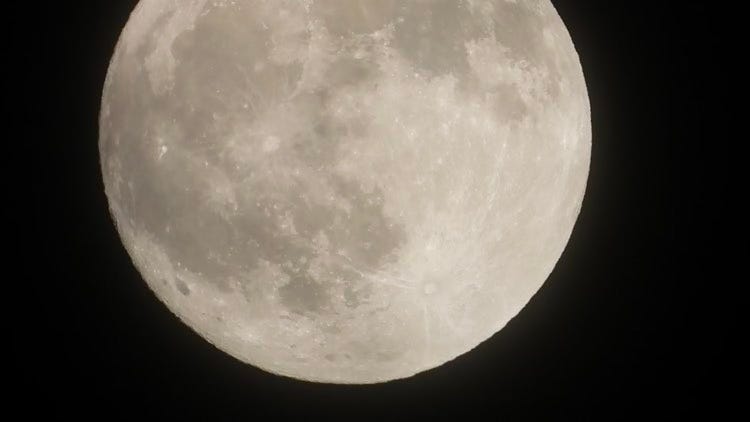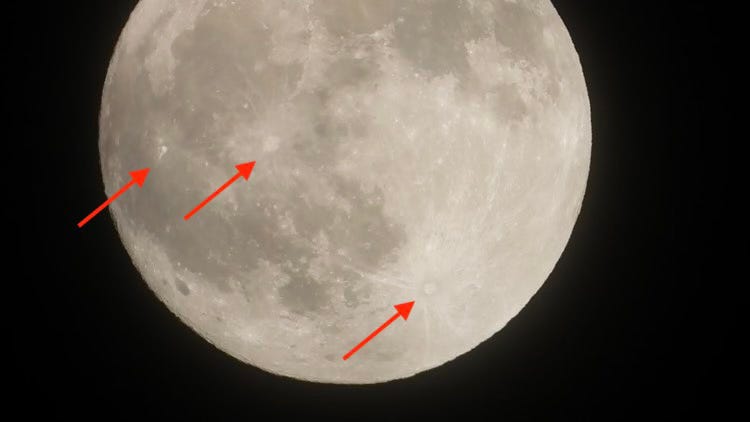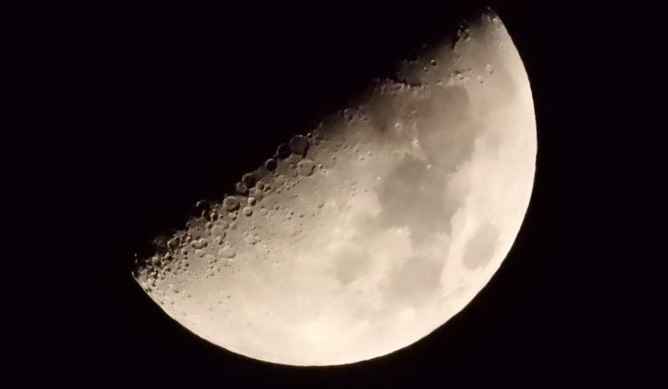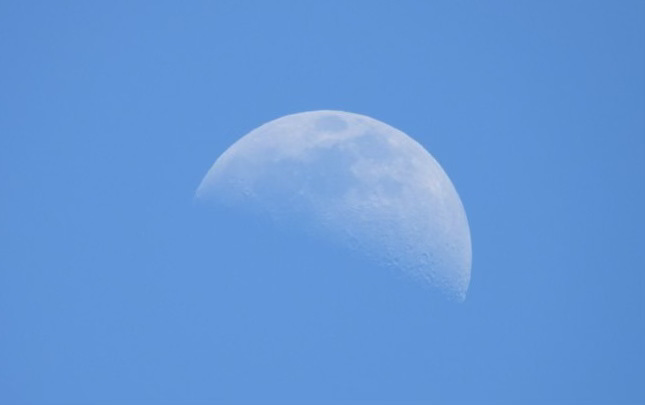A highly respected pastor recently shared a much-recited anecdote about the moon — a story with the power to bring people to tears and draw them into a deeper relationship with Christ. Men have penned books on the topic. And I myself have written a poem and an essay on the subject. In the past, the tale felt so true in my heart — that I too was given over to the emotion of it. Sadly, I had never looked to the Bible to see if the telling was true. After discovering the truth about Biblical Cosmology, I realize it is nothing more than a yarn, a counterfeit of something more beautiful.
So what is the old story?
I suspect the following account will resonate with your heart and memory.
The Moon Yarn
Here is the story of the moon as told by a favorite pastor in a recent worship service.
He shares:
When we consider that we are supposed to be holy like God is holy, it could be very discouraging unless we realize that our holiness comes from God Himself. Justification is His righteousness imputed to us; sanctification is His holiness imparted within us.
You can just think of the analogy of a moon. The moon has no light of itself. It’s just reflecting the light of the sun. And in the same way, we are just reflecting back what God has already given to us. And so this morning, Satan might tempt you to think that your light is too weak and too pitiful to be of much use. But Satan’s simply tempting you to look at yourself, the moon, the rock, and say, “I’m nothing.” But it doesn’t matter. You’re designed by God to reflect His light and to reflect His glory.
And so no matter what your discouragements from the past week, I would encourage you to take your eyes off of yourself and put them on Jesus. No matter how small your faith might be, it doesn’t matter. Your faith just needs to look to the Lord Jesus. 1
How can one NOT get goosebumps and a refreshed faith when hearing those words? And to be sure the theme is true. We do not have a righteousness of our own. It comes from Christ alone. However, does the analogy as delivered above accurately describe the nature of the moon according to the Bible?
The Moon Poem
Here’s another version of the story written as poetry instead of prose. Andrew Otto published “I Am the Moon” as a tract to draw people to their Creator. I personally purchased 25 copies to hand out as a tool for evangelism.
No doubt, the book has a beautiful message.
I Am the Moon
I once wished to be a star creating my own light
Full of splendor from afar to sparkle in the night.
But in truth, I am the moon
My surface marred with scars
An imperfect, cratered dune
Much different than the stars
There is another source of light
Which gives all life to earth
One whose glory shines so bright
It causes dawn to birth
At times I barely see the light
A crescent of what should be
The world makes my reflection slight
Obscuring His light from me
But when the sun I fully gaze
Beholding His radiant power
His beams of light set me ablaze
Despite the darkened hour
The poem goes on to compare the Sun with the Son — which the Bible also does.
However, the question remains: do the homily and the poetry speak accurately about the moon?
A Reflection on the Moon
Both stories as shared above carry common themes about the moon. Here are five we will consider:
The moon does not have its own light;
The moon is a rock or cratered dune;
The moon reflects the sun’s light;
We are like the moon and God is like the sun;
Therefore, we are designed to reflect God’s light.
While there is undoubtedly some beauty in the picture, metaphor, or analogy — does it line up with God’s testimony about the moon?
“Test all things; hold fast what is good” (1 Thessalonians 5:21).
We will test each claim against the Word of God — which is purified seven times and the light by which we must examine all things.
Claim #1: The moon does not have its own light.
Some Christians claim the Bible is not a science book. This argument is often made to support a belief in something other than a literal six-day creation. Young earth creationists use a similar hermeneutic when arguing against a flat, stationary earth, preferring the scientific consensus over the truth of God’s Word. In their favor — they believe the scientific community is using the true scientific method. Sadly, they are mistaken. The globe model is not based on science any more than evolution is.
If we take God at His Word, we can begin to understand the true nature of the cosmos — just as we take Him at His Word for a literal six-day creation. So when asking the question if the moon has its own light, we can trust the scientists who have given us evolution and the Big Bang theory — or we can trust the Word of God.
So what does God say about the moon having or not having its own light?
First, let’s look at Isaiah 13:10: “And the moon will not cause its light to shine.” This verse claims that the moon has its own light which it can in some way control. Isaiah 30:26 agrees that the moon has its own light: “Moreover the light of the moon will be as the light of the sun.” In this passage, the light belongs to the moon and not to the sun. Ezekiel 32:7 testifies to the same phenomena. “And the moon shall not give her light.” Interestingly, in this verse, the Bible assigns the moon a gender. It is a her. A topic for another study. Yet, the light belongs to the moon. It is her light.
Jesus Himself upholds this doctrine of the moon having its own light. In Matthew 24:29, Jesus says, “Immediately after the tribulation of those days the sun will be darkened, and the moon will not give its light.” Jesus uses a possessive pronoun when discussing the light of the moon. Lest one say that the reason the moon will not give its light is because the sun is darkened. The verse next says “and the stars shall fall from heaven.” These are separate events, not one event causing another. See also Mark 13:24.
Below is a picture of the moon that I took with my Nikon P-1000. Notice how you can see rays of light coming from within the moon. I have pointed to three distinct locations where the light emanates from the moon — though there are more than three. Zoom into the picture for more clarity if you don’t see it at first glance.
Observation indicates that the moon has its own light just as the Scripture testifies. And this should become even more apparent as we proceed to the remaining claims.
Claim #2: The moon is a rock or cratered dune.
To understand the nature of the moon, it seems best to start at the beginning when it was created. But let’s cover a few curiosities first. I don’t deny that the moon appears to have craters. My own photographs show them. Images with closer detail make the crater-like structures in the moon even more vivid.
I also know it is hard for Americans NOT to think of the moon as a rock — since, in 1969, the world watched astronauts on television walk upon its dusty surface. However, scientists from the beginning have questioned the validity of the moon landing, claiming it would be impossible to land on the moon because it was not a solid surface, but rather a plasma that is transparent under certain conditions.2
I took the following picture on June 25, 2023, at 4:02 in the afternoon with my Nikon P-1000 camera. Where is the other half of the moon?
Additionally, I have seen enough evidence to conclude that the moon landing was a Hollywood hoax. I’ll share three videos for the serious researcher to consider when validating the moon landings. Consider watching them in the following order.
A Funny Thing Happened on the Way to the Moon by Bart Sibrel shares leaked video footage of the Apollo 11 astronauts faking images of the Earth from “space.” Interestingly, the extra video footage, telemetry data, and technology from the moon landing have conveniently been destroyed or lost. There is also evidence to suggest that Stanley Kubrick directed the moon landing film project.
Capricorn One starring James Brolin is an entertaining Hollywood movie. Consider using a language filter since there are characters who take the Lord’s name in vain. We purchased the Enjoy App so we could watch the movie on YouTube without hearing 3C violations. Capricorn One was released in 1976 — several years after the supposed moon landing. Sibrel takes his title from a line in this movie, “A funny thing happened on the way to Mars.” Take note of the astronauts’ faces as they tell their wives that they are on a mission to Mars.
The Apollo 11 Press Conference with astronaut heroes Buzz Aldrin, Neil Armstrong, and Michael Collins reveals a lot to those willing to examine the evidence. Ask yourself if these three men look like they just went to the moon — or do they remind you more of the astronauts from the movie Capricorn One? The astronauts can’t even agree on whether or not they saw any stars on their journey. Is that something you’d forget?
I’ve provided this evidence to help make what the Bible teaches about the moon more palatable. It is so easy to trust so-called science, NASA, and statist organizations (even though we know they are controlled by liars, perverts, and God-haters) — rather than to trust the clear teaching of Scripture.
So what does the Bible say about how the moon was created?
To the Word and the Testimony
God created the moon and placed it in the firmament on day four of creation. The first mention of this event is recorded in Genesis 1:14 when God said, “Let there be lights in the firmament of heaven to divide the day from the night.” So from the first mention, the moon is called a light placed in the firmament of heaven. The next verse gives the purpose of the lights, “‘And let them be for signs and seasons, and for days and years; and let them be for lights…to give light on the earth’; and it was so.” Again, the lights in the firmament had a purpose — to give humans the ability to tell times and seasons without NASA, a watch, or even a smartphone — and to give light to the earth. The lights in the sky were made as a clock with perfect precision — and they remain so to this day. Yet, we have lost the knowledge — or rather it is being hidden from us. See the footnotes for more information about the sky clock.3
Verse 16 gets more specific about the creation of the moon. “Then God made two great lights: the greater light to rule the day, and the lesser light to rule the night. He made the stars also.” Here again, it does not say that God created a rock or a cratered dune. God calls the moon a light — even a great light, the lesser of two.
Then, God set the sun, moon, stars, and wandering stars (fallaciously called planets) in the firmament of heaven “to give light on earth, and to rule over the day and over the night, and to divide the light from the darkness. And God saw that it was good. So the evening and the morning were the fourth day” (Genesis 1:17-19).
God testifies that the moon is a light and a clock — not a rock or cratered dune. By nature, the moon is a great light with a given purpose.
And God said that His great light, the moon, and the purpose for which it was created — was good, even very good.
Claim #3: The moon reflects the sun.
It seems that this claim has already been busted by exposing the first two as false. However, there is more to add to this part of the discussion.
First, I’d like to mention that there is an observable connection between the moon phases and its relative position to the sun. The moon travels at a different rate than the sun. If we were to observe the sun in the sky, it would take 24 hours to make a circuit in the heavens — or from an observational standpoint — it would return to the same location in the sky in about 24 hours — though its position changes slightly during a yearly cycle. This is part of the sky clock mentioned before. It’s also what causes seasonal changes on the earth. Over a year, the sun’s ecliptic makes an analemma that looks like a figure eight.
The moon closely follows the sun’s ecliptic — within five degrees above or below its analemma, yet not always at the same time. This is because the moon travels a bit slower than the sun, traveling one observable circuit in about 24 hours and 51 minutes.45
When the moon is 180 degrees from the position of the sun — the moon is full. When the sun and moon are in the same position in the sky, there is a new moon. The moon waxes (gets bigger) between new and full and wanes (gets smaller) between full and new. So the closer the sun is to the moon in the ecliptic, the less light the moon has. Yet, as the moon travels further away from the sun, its light increases.
Here is a simple video illustration of how the position of the moon changes in one lunar cycle.
Furthermore, If you observe the moon and the sun when they are both visible during daylight hours it becomes obvious that the moon is not reflecting the light of the sun. This was one phenomenon that prodded me to research Biblical Cosmology.
We’ve already seen the Bible testify that the moon is a light (not a rock or cratered dune) and that SHE has her own light, but does the Bible ever talk about the moon reflecting the light of the sun?
Here’s an interesting bit of trivia. The NKJV of the Bible never uses the words reflect, reflecting, reflection, or reflected save once. And in that instance, the word is in italics — which means it was added to the text for clarity.
“As in water face reflects face, So a man’s heart reveals the man” (Proverbs 27:19).
Other translations, such as the NIV, use the word reflect more often — yet usually to mean an action of considering, as to reflect upon a truth in your heart or mind.
If God created the moon to reflect the light of the sun — don’t you think He would have at least mentioned the idea in the Bible?
This will become a more critical distinction when we consider the last two claims.
Claim #4: We are like the moon and God is like the sun.
While the analogy of the sun and moon could be used with the biblical model, God never makes it Himself. True, the Bible does liken God to the sun, but He never likens humans to the moon except in specific metaphors that are clearly defined.
If you do a word search to see how the Bible talks of the moon, you’d likely find the major category of uses as defined below.
What does the Bible say about the moon?
A Created Light: God created the moon as a light (Genesis 1:14-19; Psalm 104:19, etc.).
For Days and Seasons: God gave the moon as part of His sky clock to delineate times and seasons (Genesis 1:14).
A Defined Metaphor: In a dream, Joseph likens his father to the sun and his mother to the moon — and his brothers to stars (Genesis 37:9). He also likens these same to sheaves in the field that bowed to him (Genesis 37:7). Solomon’s Song also praises his bride for being as fair as the moon — but also as clear as the sun (Song of Solomon 6:10). Never once is a reflection of the sun intimated.
An Object of Idolatry: God warns about worshipping the moon (Deuteronomy 4:19; 17:3, etc).
For Celebrations and Feasts: New Moons were times for celebrations and feasts (Numbers 29:6; 1 Samuel 20:18; etc.).
An Object under Submission: The moon stood still at God’s command (Joshua 10:13; Habakkuk 3:11, etc.).
Created to Praise: The sun and moon praise God along with all the host of heaven (Psalm 148:3).
Eclipsed by God: God’s light puts the light of the sun and moon to shame (Isaiah 24:23; 60:20, etc.).
For Signs of Turmoil: The moon gives signs in heaven when distress comes upon the land (Acts 2:20; Revelation 6:12; etc.).
As Having Glory: The moon has its own glory — a glory separate from the glory of the sun (1 Corinthians 15:41).
Again, never once in the Bible is the moon seen as an object that reflects the sun’s glory. Rather, it has a light and a glory of its own.
Yet, since the moon is a light — and we too are called to be lights in the world — one could make the connection that we too ought to shine in the darkness. The moon is a light placed in the tent of heaven by God Himself, a light that waxes and wanes — yet endures forever (Psalms 89:37). And when we examine the final claim, we will see how inaccurate it is to say that we ought to reflect God’s light.
Claim #5: We are designed to reflect God’s light.
I know how tempting it is to believe the claim that Christians are designed to reflect God’s light — but it is just not true. And when you see the truth as presented by God — and use the true metaphor instead — it is far more beautiful and theologically correct.
Satan loves to substitute lies for truth and create counterfeits that seem like the real deal. However, truth always trumps trickery. I hope you will see this in my final point.
I’d like to reiterate that the concept of the moon reflecting the sun’s light never appears in the Bible. Neither does the metaphor that we reflect God’s light like the moon reflects the sun.
So what does Jesus teach us about our light? And how does that light compare with the moon?
First, Jesus tells us that we should not hide our light. “Let your light so shine before men, that they may see your good works and glorify you Father in heaven” (Matthew 5:16). How does that compare to the moon? By design, the moon hides its light in a regular pattern. When it is closest to the sun, it has the least amount of light. When it is furthest from the sun, it has the most light. This should be the opposite if it were to be a metaphor for humans reflecting God’s light.
Second, and most profound, is the fact that we do not reflect God’s light at all. Rather, His light is in us. Now here we could accurately use the metaphor of the moon if we were to acknowledge that it has its own light. And it is true that the light in us waxes and wanes depending on how closely we look upon Jesus, the author and perfecter of our faith. But it ought not to wax and wane — we ought to be constantly going to the Holy Spirit to refill us with God’s light so that we can shine our brightest at all times.
“You are the light of the world. A city that is set on a hill cannot be hidden. Nor do they light a lamp and put it under a basket, but on a lamp stand, and it gives light to all who are in the house. Let your light so shine before men, that they may see your good works and glorify your Father in heaven” (Matthew 5:14-16).
Yet — when we do wax and wane like the moon — God still counts us faithful. Why? Because we have Christ in us, the hope of glory, and the source of our light. Just as we can wax and wane and remain faithful because of Christ in us, so does the moon. “It shall be established forever like the moon, Even like the faithful witness in the sky” (Psalm 89:37).
We too, like the moon, should draw near to the Son when our light is getting weaker — so we can power up the light that is within and shine among the world to bring Glory to God. Despite our failings, we can always go to the source of light to be refilled and refreshed. Not to reflect God’s glory — but to shine it from the inside out — just like the moon.
I’d like to end by revisiting the homily I shared above from my favorite pastor. He opened his moon story with these words: “When we consider that we are supposed to be holy like God is holy, it could be very discouraging unless we realize that our holiness comes from God Himself. Justification is His righteousness imputed to us; sanctification is His holiness imparted within us.”
He too understands that we don’t reflect the light — but rather it dwells in us. He just hasn’t lined up his cosmology correctly. I pray that he will.
https://www.youtube.com/live/Os7ZbWH7kag?si=GdDaSsY2i_gtg2F4&t=745
David Weiss released a mobile app called the Sun, Moon, and Zodiac Sky Clock. It contains a plethora of Flat Earth resources. Use discernment when viewing the information. It does not all come from a biblical perspective. However, it is a handy tool to see how the sun and moon work together like a clock. Download the app here: https://qrco.de/bbizVA and use referral code FEHOPE — the app is $3.99 and can be upgraded for $10.99/year. A smart investment, IMO.
An even more fascinating look at the sky clock is the rediscovery of an ancient device called the Antikythera Mechanism. Before the Internet or NASA was even a dream — astronomers could pinpoint eclipses, sun, moon, and star movements, and so much more. That’s because they were studying the patterns God placed in the sky for days, months, and years. The Mechanical Realm movie talks about the Antikytera Mechanism in more detail. Use discernment. The filmmakers overplay the Flat Earth card in this movie, IMO. Plus, they throw in some New Age mumbo jumbo. Still worth a watch.
https://www.astronomy.com/observing/does-the-moon-follow-the-same-path-across-the-sky-as-the-sun/








